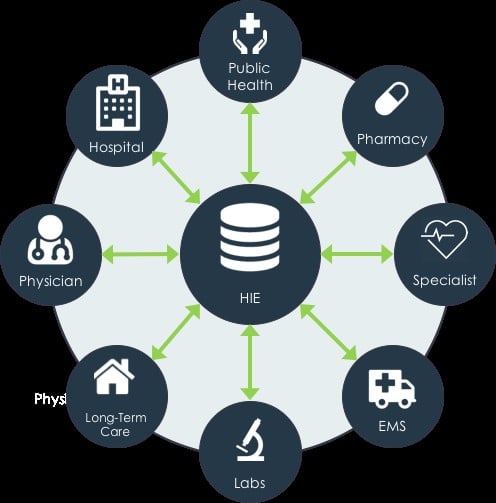Interoperability Part 2: What’s Next?
Now that you have a solid idea of what interoperability is and why we haven’t quite figured it out all yet (Read Interoperability Part 1: What is it & How Does it Relate to EMS), I bet you’re wondering: How do we get there? We’ll discuss this (and a little more) in this blog post
Was this information valuable?

Now that you have a solid idea of what interoperability is and why we haven’t quite figured it out all yet (Read Interoperability Part 1: What is it & How Does it Relate to EMS), I bet you’re wondering: How do we get there? We’ll discuss this (and a little more) in this blog post. The interoperability community is slowly coming together to reach our common goal.
Deep Dive into the Standards & What They Mean
One of the things they are working on is the standardization of standards; which have made great progress in recent years. There are a lot of overlapping and competing standards that are being defined, but we’re definitely seeing some progress in a forward direction. These newer, more modern standards provide more flexibility to pull data, query and retrieve results on demand, and streamline delivery versus just pushing data. Let’s take a look at some important standards for you to understand in terms of interoperability.
Health Level 7 (HL7) – is one of the organizations establishing standards for language/framework/standards used for exchanging healthcare information. HL7 is developing a new standard: the Fast Healthcare Interoperability Resources (FHIR – pronounced as fire — I had to learn a few years ago when talking to interoperability resources when I said I worked for a software company that provided solutions for EMS and fire, my fire was different than there FHIR).
FHIR is a draft standard describing data formats and elements (known as "resources") and an Application Programming Interface (API) is used to exchange electronic health records and makes it easier to send and receive data in a standardized format.
Clinical Document Architecture (CDA) is the standard that defines structure for certain types of medical records; for example, progress/treatment notes and discharge summaries that are exchanged from provider to provider and provider to patient. The CDA EMS Run Report that ZOLL uses is one of several CDA standards, and FHIR is moving toward a consolidated CDA, which is a standard that will provide the means to create templates based on several CDA standards. This will take some investment and focus in researching the applicable templates we would use.
Integrating Healthcare Enterprise (IHE) is an organization (similar to HL7) that establishes standards to handle messaging and transactions between systems.
What Role Does the Health Information Exchange Play?
We’re also seeing real movement in Health Information Exchange (HIE) area. HIE acts as the hub between all of the different components and allow us to send and receive standardized data (see the image below).

As you can see, there are many spokes on the wheel to share data. For example, we send out EMS PCR data with the goal to get outcomes data back from hospitals.
However, the definition of an HIE is transforming over time. We’re starting to see it’s moving from a noun to a verb. In other words, HIE used to describe more of an organization that manages data exchange, but the industry now uses the HIE term to describe the action of data exchange/interoperability. State and regional HIEs are diminishing, and the growth of electronic medical record (EMR) vendors creating HIE platforms are growing. For example, the EMR system Cerner uses is CommonWell while Epic uses CareQuality.
Is There Value in EMS Data for the Healthcare Environment?
Yes! Outcomes data can be incredibly valuable for EMS. We can assess the impact we have on the patient’s health beyond the visit in the ambulance. We can start seeing trends with medications administered or the positive outcomes associated with a particular protocol.
For instance, when a patient experiences an acute, time-dependent illness or injury, their care is tracked at a more granular level to ensure that they’re getting the proper treatment and to track their progress over time. So, when there is a STEMI, stroke, cardiac arrest, respiratory distress, trauma or Sepsis, it’s important to flag those instances and to track the care outcomes. Registries such as CARES for cardiac arrest help track this outcomes information on patient populations over time as well as track the full continuum of care provided to patients. Outcomes data allow us to provide training and education, and can determine the protocols and medications used in the future. It also connects individual providers with other providers.
How is ZOLL Involved with Interoperability?
Even though the industry is progressing slower than we would like, ZOLL is making some significant strides in interoperability that we’re excited about. Examples include:
- We currently support a number of HIE integrations. We’ve learned a lot about new connection methods that can be leveraged to send our PCR data using the HL7 CDA EMS Run Report. For example, Epic’s CareQuality can accept the CDA EMS Run Report when submitted using an IHE standard as a wrapper to communicate. Additional and current implementations include CareQuality and New York’s Healthix HIEs.
- Custom and off-the-shelf software integrations have been done by our Custom Solutions team to integrate third-party vendor data and RescueNet products. These integrations have solved many problems for 911 centers, medics and billers.
- Device integrations. I know we’ve talked a lot about getting data from our products and out to other vendors, but incoming data is just as important. ZOLL currently supports data feeds from our own monitor data along with our competitors.
- Vendor member of interoperability communities. ZOLL is the only EMS technology vendor that’s currently a member of CareQuality and the eHealth Exchange. Carequality is a public-private, multi-stakeholder collaborative that has come together to meet the challenge of creating interoperability between the various healthcare members. The community, drawn from all parts of the healthcare ecosystem, uses a consensus-based process to enable seamless connectivity across all participating networks to connect networks across the nation. eHealth Exchange is the largest and fastest growing health information exchange network in the United States. We’re currently engaging with the market and other vendors to understand the opportunities available.
- Health Information and Management Systems Society (HIMSS) is the largest healthcare conference in the world with 42,000 attendees, 1,200 exhibitors. The conference features an interoperability showcase with 19 demonstrations, 117 systems integrated across 66 organizations and 7,482 visitors.
Related Posts
ZOLL Pulse Blog
Subscribe to our blog and receive quality content that makes your job as an EMS & fire, hospital, or AR professional easier.
ZOLL Pulse Blog
Subscribe to our blog and receive quality content that makes your job as an EMS, fire, hospital, or AR professional easier.




